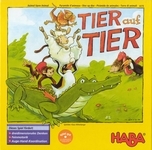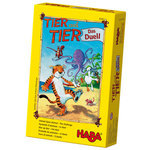

|
I was dumbfounded to discover that there are no strategy articles out there to be found on the deeply strategic game Tier auf Tier. This is a game that requires complete mental focus, a great deal of experience, and a firm grasp on all the possibilities and their potential ramifications. Beginners sometimes overlook the complexity of Tier auf Tier, failing to appreciate the nuance of this brain burner. I’m here to help run through many of the classic positions and moves that any self-respecting Tier auf Tier player needs to master.
 First off, there’s the classic yet elusive “double hog” maneuver. A fine example of needing to know the attributes of your playing pieces. Just as a chess player must fully grasp the various uses of the bishop as opposed to the rook, a Tier auf Tier player must do likewise, but take it to a whole other level by understanding all of the different possible orientations of their pieces as well. A discerning player will immediately recognize and appreciate the benefits and pitfalls of the ridges on the hedgehog’s back. These can be used for many purposes, but the “double hog” is the most solid and stable. This is when one hedgehog has been placed on its stomach and the other is placed above lying on its back. The animals interlock with an almost zipper-like bond that can be used as the base for a wide variety of follow-up plays.
First off, there’s the classic yet elusive “double hog” maneuver. A fine example of needing to know the attributes of your playing pieces. Just as a chess player must fully grasp the various uses of the bishop as opposed to the rook, a Tier auf Tier player must do likewise, but take it to a whole other level by understanding all of the different possible orientations of their pieces as well. A discerning player will immediately recognize and appreciate the benefits and pitfalls of the ridges on the hedgehog’s back. These can be used for many purposes, but the “double hog” is the most solid and stable. This is when one hedgehog has been placed on its stomach and the other is placed above lying on its back. The animals interlock with an almost zipper-like bond that can be used as the base for a wide variety of follow-up plays.
The “hanging toucan” is another important move to master and also more commonly seen in the wild than the “double hog.” The toucan’s bill is its most important attribute and a feature that must not be overlooked. Through the careful use of this attribute, the toucan can be used almost anywhere. You can place the toucan such that it’s beak rests on another animal’s back, while the body of the bird itself is hanging off in thin air. It can sometimes be a precarious maneuver to execute, but a particularly successful “hanging toucan” will rattle your opponents so much that they’re sure to slip on their next move. The psychological element of Tier auf Tier is something that many beginners overlook but is just as important to consider as the physical element.
For more advanced players who are ready to consider the interaction of the die with the figures, there is the bold “drunken penguin” play. This is used when an opponent rolls a question mark and you have the chance to select his or her next placement. Many players mistakenly jump to the sheep, or the octopus if making use of the advanced expansion, but a discerning player will consider the circumstances and the board position. In the early game, it is often wise to execute the “drunken penguin” by making your opponent use up his penguin early, thereby wasting it. The penguin is the exit strategy for all high-level players who find themselves in a tricky situation, so don’t underestimate the advantage of wasting an opponent’s penguin in the early stages of play. Just make sure not to pursue the “drunken penguin” strategy in the late game. This move truly requires a complex analysis of the game state that is only recommended for experienced competitors.
The “snake bridge” is a bit easier to master from a mental perspective since it requires less analysis, but is more difficult from a physical perspective, with a high degree of difficulty and a high risk quotient. There are times when the figures have been structured into two distinct towers and that is the ideal time to wow the opposition by busting out a “snake bridge.” It sounds simple enough in theory, you just position the snake unit so that it spans the gap. In practice, this is a delicate maneuver that requires total concentration. You must add the “snake bridge” to your repertoire, but be cautious about when you pull it from your tool belt because when used improperly it can result in an enormous setback.
 I hesitate to delve into the added complexity of the additional four figures found in the Das Duell expansion, but I’ll briefly mention the “inverted goose” for the most advanced players to contemplate. Once you have a great deal of experience with the game, you may want to add the octopus, tiger, squirrel, and goose found in the Das Duell expansion. These bring each player’s total figures up to 11, which makes for an extremely challenging and emotionally draining experience. If you’re going to enter this arena, make sure you pay particularly close attention to the complexities of the goose. The figure’s long neck and weight distribution make for some difficult moves and undoubtedly many sleepless nights tossing and turning. To help conquer this Everest, I’d recommend practicing the “inverted goose.” This is when you wedge the goose’s head down into a crevice with its feet towards the sky. You’ll obviously need to play many solitaire sessions to practice, but in the long run it will be worth it.
I hesitate to delve into the added complexity of the additional four figures found in the Das Duell expansion, but I’ll briefly mention the “inverted goose” for the most advanced players to contemplate. Once you have a great deal of experience with the game, you may want to add the octopus, tiger, squirrel, and goose found in the Das Duell expansion. These bring each player’s total figures up to 11, which makes for an extremely challenging and emotionally draining experience. If you’re going to enter this arena, make sure you pay particularly close attention to the complexities of the goose. The figure’s long neck and weight distribution make for some difficult moves and undoubtedly many sleepless nights tossing and turning. To help conquer this Everest, I’d recommend practicing the “inverted goose.” This is when you wedge the goose’s head down into a crevice with its feet towards the sky. You’ll obviously need to play many solitaire sessions to practice, but in the long run it will be worth it.
I’m sure that’s more than enough material for now and your head is spinning so I’ll leave it at that. If you practice these maneuvers, study the figures carefully, and train to achieve total concentration then you may just make a fine Tier auf Tier player one day. It’s not a lifestyle for everyone due its demanding rigors, but the truly devoted should persist in the pursuit of animal stacking excellence.
(See The Opinionated Gamers for this column plus additional comments on it)